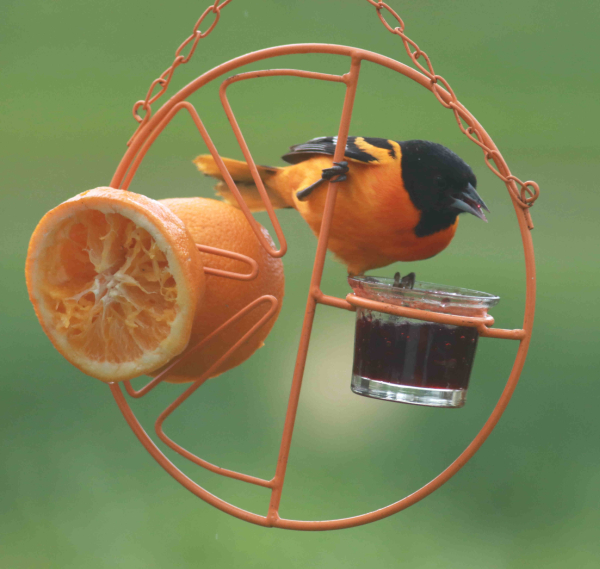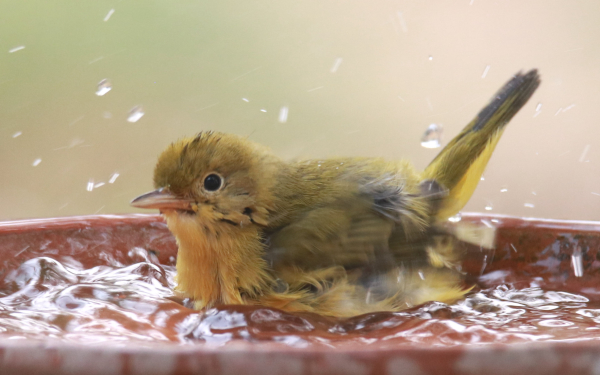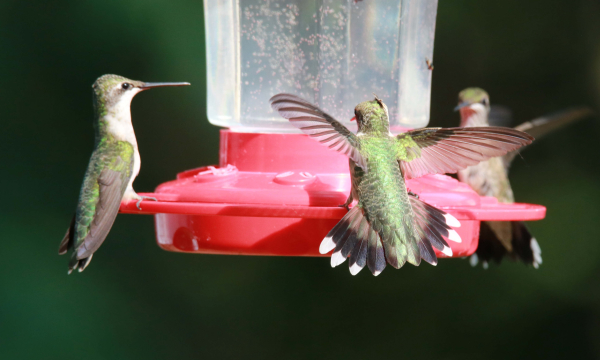
It’s time to be stocked up for orioles with cut oranges and grape jelly.

Providing drinking water and a bathing basin will increase the number of songbirds that are attracted to your yard, like this Yellow Warbler that stopped for a drink and a bath (photos by Paul Konrad).

Feeding hummingbirds might be the most popular bird feeding activity in America, among birders and others.
|
Throughout May and the first week of June, during the on-going migration of songbirds, water is the critical element for many birds that are making momentary or extended stops in our yards or the surrounding area. Your landscaping will provide a place to rest and forage for caterpillars and bugs. Likewise your feeding station with water can be essential for migrating songbirds, so be sure to make your water features and feeders a focal point: Be sure they are filled with fresh water and nutrients throughout the day, every day.
A well-stocked feeding station begins with a never-ending source of fresh water, which will benefit any birds, but especially migrants that have been flying overnight and part of the morning. This is especially true for the many insect eaters that aren’t as apt to be attracted to feeder foods, especially the many warblers, thrushes, vireos, and others.
Building on the usual seeds that will attract finches, grosbeaks, buntings, native sparrows, nuthatches, woodpeckers, and more, be sure to stock sunflower seeds and nyjer thistle seeds. No-melt suet is a year-round energy source. Now it’s time to keep your hummingbird feeder stocked with sugar-water nectar and, especially for orioles, provide sliced oranges and plent of grape jelly. Some orioles go for sugar-water nectar too, but grape jelly is the food of choice that keeps them coming throughout migration – and it may keep some pairs returning throughout the nesting season.
As an added incentive to providing a variety of fresh foods and water, it is possible to short-stop some birds to nest in your neighborhood that might otherwise move on in search of a suitable nesting area. We are confident we have done this multiple years with Baltimore and Orchard Orioles, Gray Catbirds, and Ruby-throated Hummingbirds, but probably other species that reacted to our landscaping, foods, and water resources.
According to US government officials, bird flu is not a factor for songbirds, so backyard birders with feeding stations should continue to provide for birds as we always have. Nonetheless, it is always important to keep our feeding station clean for regular visitors, and now for newly arriving birds too – the birds we’ve been waiting to return since they headed south last fall.
There is still time to add some hummingbird flowers – potted or planted, or both – to your yard, and you can build on initial flowering plants you select by adding summer blooms later. Red, pink, orange, and yellow tube-shaped flowers are best, and hummingbirds really zero in on the red blooms because they provide the best nectar.
Enjoy this exciting period as new birds arrive, as migrants and seasonal residents add vibrant songs and activities to your yard that have been absent for all too long. Spring migration will bring new birds that can make your day as new species arrive week by week. This is truly an exciting time of the year when all you have done in recent weeks, and during previous years in the case of landscaping and gardening, pays big benefits for you, your family, and the neighborhood as trees bloom and sprout new leaves, flower gardens flourish with the first spring colors, and the sight and sounds of birds that surround you daily renew your spirit and your surroundings.
You can also use this spring period to get to know more about the new birds you see, and reacquaint yourself with longtime favorites returning for the green season. You can get species by species information about North American birds provided by the Cornell Lab of Ornithology at the All About Birds website at Search, All About Birds, Cornell Lab of Ornithology
And for 5 upcoming days – May 11 to 15 – you can use Birds of the World free to search out interesting information, photographs, sound recordings, and range maps of any birds you can think of at Birds of the World We think it’s the best source of information about all birds, including birds found in North American backyards - it’s an entire bird library in one place, at your fingertips. We renewed our annual subscription last week, which amounts to just $4 per month.
This is the period when we should be offering the most variety of bird foods to attract and benefit the greatest variety of birds. And water attracts and benefits a greater variety of birds than all the foods we can offer combined. Take some extra time to enjoy the action at your feeding station, and don’t hesitate to grab your binoculars and take a little walk around your yard. Relax on a deck or balcony with those binoculars close at hand, and see how many birds land in nearby trees and bushes. It’s that time of the year when you really should enjoy the fruits of your yard, along with the birds that make it all the more special.